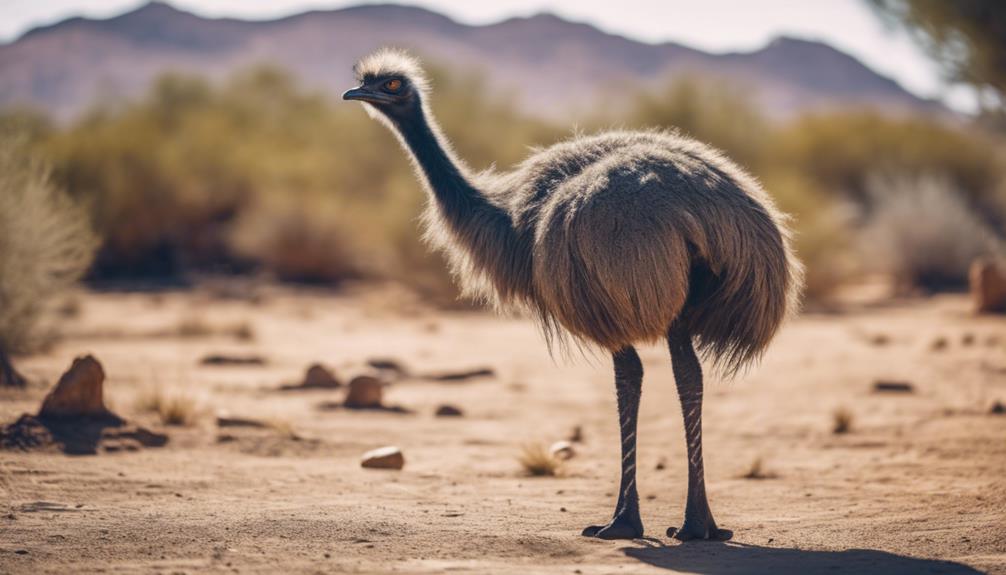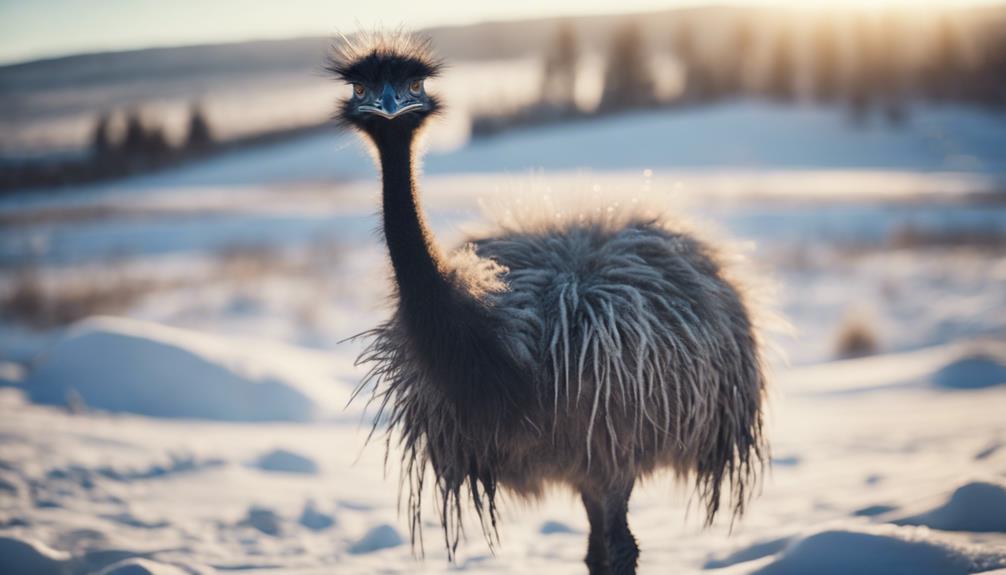
Did you know that emus can reach speeds of up to 30 miles per hour while sprinting?
These remarkable birds have evolved various strategies to thrive in diverse habitats, showcasing their adaptability to different environments.
From physical adaptations for aridity to behavioral flexibility in wetlands, emus have honed a range of skills to survive and thrive.
As you explore the intricacies of how emus navigate various landscapes, you'll uncover a fascinating world of evolutionary tactics at play.
Key Takeaways
- Emus showcase diverse foraging techniques and feeding strategies to survive in varying habitats.
- Behavioral adaptability helps emus adjust breeding habits and communication styles for ecological success.
- Genetic diversity aids emus in coping with environmental changes and thriving in different ecosystems.
- Emus migrate strategically based on food availability and weather patterns, ensuring survival and reproductive success.
Physical Adaptations for Aridity

Emus in arid environments have developed specialized physical adaptations to thrive in harsh conditions, such as their ability to regulate body temperature efficiently. These physiological adaptations are crucial for their survival in regions where water is scarce. One remarkable feature is their ability to conserve water effectively. Emus can limit water loss through several mechanisms, including reduced respiratory water loss and efficient kidney function.
Their physiological adaptations allow emus to withstand long periods without water. For instance, they've a lower metabolic rate compared to many other birds, which helps reduce water requirements. Additionally, emus can tolerate high body temperatures, which aids in water conservation by minimizing sweating and panting.
Feeding Strategies in Grasslands
In grassland environments, the availability of food sources significantly influences the feeding strategies employed by various species to ensure optimal nutrition and energy intake. Emus, known for their adaptability, exhibit distinct grazing behavior and dietary preferences that aid in their survival in these open habitats. Emus are selective feeders, preferring a variety of plant species such as grasses, herbs, and shrubs. Their diet is rich in fiber and low in protein, aligning with the nutritional requirements of their large, flightless bodies. To emphasize this point further, consider the following table:
| Dietary Preferences | Grazing Behavior |
|---|---|
| Grasses | Selective |
| Herbs | Opportunistic |
| Shrubs | Seasonal |
Understanding emus' grazing behavior and dietary preferences in grasslands is crucial for conservation efforts and ecosystem management, highlighting the intricate relationship between these unique birds and their environment.
Behavioral Flexibility in Wetlands

Exhibiting remarkable adaptability, wetland-dwelling emus demonstrate a high degree of behavioral flexibility in response to the dynamic environmental conditions present in these water-rich habitats. These large flightless birds have evolved specific strategies to thrive in wetlands, showcasing their ability to adjust behaviors based on the unique challenges and opportunities these ecosystems offer.
- Breeding Habits: Wetland emus adjust their breeding habits to coincide with the availability of resources. They time their breeding seasons to align with periods of abundant food supply, ensuring optimal conditions for raising their young.
- Nesting Behaviors: Emus in wetlands exhibit diverse nesting behaviors, constructing their nests in elevated areas to avoid flooding during the wet seasons. This behavior minimizes the risk of nest destruction and enhances the chances of successful incubation.
- Foraging Techniques: Wetland emus display versatile foraging techniques, utilizing their long necks to reach aquatic plants and insects in shallow waters. This adaptive behavior allows them to capitalize on the rich food sources present in wetland environments, contributing to their overall survival and reproductive success.
Reproductive Tactics in Woodlands
Adapting their reproductive tactics to the woodland environment, wetland-dwelling emus demonstrate a shift in their breeding strategies to navigate the distinct challenges and opportunities presented by these forested habitats.
In the woodlands, emus modify their courtship displays and mating rituals to suit the denser vegetation and different predators that may be present compared to wetland areas. Courtship displays become more intricate, with males often utilizing the cover of trees and bushes to showcase their prowess through elaborate dances and vocalizations to attract potential mates.
Mating rituals in the woodlands also evolve, with emus adapting their behaviors to ensure successful reproduction amidst the new surroundings. The wooded environment requires a more nuanced approach to courtship and mating, as visibility may be reduced, and the need for effective communication becomes paramount.
Social Hierarchies in Mountains

Emus residing in mountainous regions establish intricate social hierarchies to regulate resource access and maintain group dynamics efficiently. Dominance dynamics play a crucial role in shaping the relationships among emus in these challenging terrains.
Here's a closer look at the social interactions within emu communities in mountainous areas:
- Dominance Hierarchies: Emus in mountainous regions form clear hierarchies where individuals assert dominance through displays of aggression or assertive behaviors.
- Resource Allocation: The dominant emus often have priority access to food and water sources, ensuring their survival and reproductive success.
- Group Cohesion: Despite the presence of dominance dynamics, social interactions within emu groups in mountains also serve to maintain cohesion and cooperation, essential for their overall well-being and protection against predators.
Understanding these intricate social hierarchies provides insights into how emus adapt and thrive in mountainous environments, showcasing their remarkable abilities to navigate complex social structures while ensuring individual and collective success.
Navigating Coastal Habitats
Coastal habitats present emus with a diverse array of challenges and opportunities for survival and adaptation. Emus have evolved unique behaviors to thrive in these dynamic environments. Coastal foraging is a crucial adaptation, allowing emus to feed on a variety of plant species like samphire and coastal grasses. This behavior provides essential nutrients while minimizing competition with other species in the area. However, emus must remain vigilant as marine predators pose a significant threat. These predators, such as sharks and crocodiles, can ambush emus near the water's edge, requiring constant awareness and quick reflexes for survival.
| Challenges | Opportunities | Adaptations |
|---|---|---|
| Marine Predators | Coastal Foraging | Vigilance |
| Competition | Nutrient-Rich Diet | Quick Reflexes |
| Dynamic Ecosystem | Unique Plant Species | Adaptability |
Emus' ability to navigate coastal habitats showcases their resilience and capacity for adaptation in the face of diverse challenges. By honing their foraging skills and developing strategies to avoid marine predators, emus have carved out a niche in these complex ecosystems.
Thermal Regulation in Tundra

Thermal regulation in tundra environments presents unique challenges for organisms due to the extreme cold temperatures and limited vegetation available for shelter. Emus, like other tundra-dwelling creatures, have evolved remarkable adaptations to survive in such harsh conditions.
- Insulation Mechanisms: Emus in tundra regions rely on their plumage, which is denser compared to their savanna counterparts, to provide insulation against the biting cold. This thick layer of feathers traps heat close to their bodies, reducing heat loss and helping them maintain a stable internal temperature.
- Energy Conservation: To conserve energy in the face of limited food sources, emus adjust their metabolic rates seasonally. During the frigid tundra winters, they lower their metabolic rate, slowing down bodily functions to conserve energy and endure the scarcity of resources.
- Seasonal Adaptations: Emus exhibit seasonal adaptations in tundra environments by growing thicker down feathers in winter, which enhances their insulation properties. Additionally, they may alter their foraging behaviors to adapt to the changing availability of food sources, ensuring their survival in the challenging tundra habitat.
Communication in Savannas
Amidst the vast grasslands of the savannas, the intricate web of communication among diverse species plays a crucial role in navigating this dynamic ecosystem. In this open landscape, where visibility is high, vocal cues and body language are essential for survival. Emus, with their distinctive booming calls and elaborate mating dances, utilize these forms of communication to establish territories, attract mates, and warn others of potential dangers.
| Communication Type | Purpose |
|---|---|
| Vocal cues | Emus use calls to communicate over long distances, signaling alarm calls or attracting mates. |
| Body language | Emus display aggressive postures during territorial disputes and perform courtship dances to attract potential mates. |
| Environmental signaling | Emus respond to environmental cues like changes in wind patterns or the presence of predators to adjust their behavior and communication. |
| Mate selection | Emus assess potential mates based on their vocalizations, displays of physical prowess, and overall health indicators. |
| Social interactions | Emus engage in group displays to strengthen social bonds and establish hierarchies within the flock. |
Understanding these nuances of communication is vital for emus to thrive in the challenging yet rewarding savanna environment.
Migration Patterns in Plains

Emus exhibit distinct migration patterns in plains, showcasing a strategic movement strategy essential for their survival and reproductive success in varying environments. These movements are crucial for their adaptation to changing conditions and ensuring the availability of resources.
- Emus migrate seasonally based on food availability, moving to areas where vegetation and other food sources are more abundant during specific times of the year.
- They migrate to specific breeding grounds where weather patterns are optimal for nesting and raising their young, ensuring the survival of the next generation.
- By understanding the weather patterns and food availability in different regions, emus can strategically plan their movements to maximize their chances of survival and reproductive success.
These migration patterns highlight the complex strategies emus employ to thrive in the plains, emphasizing their ability to adapt to the challenges presented by their environment.
Foraging Techniques in Scrublands
In scrublands, emus employ a variety of specialized foraging techniques to efficiently locate and consume their food sources. Emus showcase remarkable adaptability in these environments by exhibiting unique burrowing behavior to access underground plant parts and insects. Their foraging strategy primarily revolves around seed consumption, where they use their beaks to pick and crush seeds found on the ground or within vegetation. Emus have also been observed to consume small rocks, aiding in the digestion process by grinding food in their muscular gizzards.
Water sources play a crucial role in emus' foraging habits in scrublands. These birds are known to travel long distances in search of water, which is essential for their survival. By strategically locating water sources, emus enhance their feeding efficiency, ensuring they've the necessary hydration to support their foraging activities. Emus exhibit a keen sense of detecting water availability, allowing them to thrive in arid scrubland environments where water may be scarce.
Predator Avoidance in Jungles

Predator avoidance in jungles requires emus to employ a combination of vigilant behavior and swift reactions to evade potential threats effectively. In the dense foliage of the jungle, emus have developed specific strategies to outwit predators and ensure their survival.
- Camouflage Techniques: Emus in jungles utilize their natural colors and patterns to blend into the surrounding vegetation, making it challenging for predators to spot them amidst the greenery.
- Warning Signals: These birds communicate using various vocalizations and body movements to alert others in the group of potential dangers lurking nearby. This collaborative effort enhances the group's overall safety.
- Quick Reflexes: Emus have evolved to react swiftly to sudden movements or sounds, enabling them to escape from predators by running at impressive speeds or swiftly changing direction to confuse their attackers.
Genetic Diversity Across Climates
Adapting to diverse climates requires emus to showcase a broad spectrum of genetic diversity that equips them with the necessary tools for survival in varying environmental conditions. Emus exhibit remarkable genetic adaptability across different climates, allowing them to thrive in a range of habitats. This genetic diversity plays a crucial role in their ability to withstand environmental challenges and ensure their survival as a species.
Evolutionary implications of this genetic diversity are profound. Emus have evolved over time to develop genetic variations that enable them to cope with changes in temperature, food availability, and other environmental factors. This adaptability has allowed emus to persist in diverse ecosystems, showcasing the power of natural selection in shaping their genetic makeup.
Ecologically, the genetic diversity of emus is of significant importance. It contributes to the overall resilience of emu populations, ensuring that they can persist even in the face of environmental disturbances or changes. By maintaining a diverse genetic pool, emus can continue to adapt and thrive in various climates, highlighting the interconnectedness between genetics and ecological success.
Frequently Asked Questions
How Do Emus Cope With Extreme Weather Conditions Such as Hurricanes and Typhoons?
When hurricanes or typhoons strike, emus rely on their instinctual responses for survival. Emus may seek shelter in dense vegetation or terrain features. Their ability to migrate and navigate helps them to avoid the worst of the storm's impact.
Can Emus Swim and How Do They Navigate Through Bodies of Water Such as Rivers and Lakes?
Emus can swim with surprising agility, using their powerful legs for propulsion. Their diving abilities are limited, but they navigate bodies of water adeptly. When encountering rivers, emus display unique aquatic behavior, strategically crossing with ease.
Do Emus Have Any Specific Adaptations for Surviving in Urban or Suburban Environments?
In urban settings, emus utilize urban camouflage to blend in with their surroundings, aiding in evading predators and human disturbances. In suburban areas, they display adept foraging skills, adapting to varied food sources available.
How Do Emus Interact With Other Wildlife Species in Their Habitats and Do They Form Symbiotic Relationships With Any Other Animals?
In their habitats, emus interact with various wildlife species, fostering complex relationships. They exhibit symbiotic connections with certain animals, benefiting from mutual cooperation. These adaptations for coexistence showcase the intricate web of interactions within their ecosystem.
Are There Any Conservation Efforts in Place to Protect Emus and Their Habitats From Human Interference and Climate Change?
Preserving emu habitats through conservation efforts is crucial for wildlife protection. Climate change impacts necessitate proactive measures for habitat preservation. Initiatives like habitat restoration and public awareness campaigns play vital roles in ensuring emus thrive.
Conclusion
So there you have it, the intricate ways in which emus adapt to various environments.
From their physical characteristics to their behavioral strategies, these fascinating birds have truly mastered the art of survival.
Like a well-oiled machine, emus seamlessly navigate different habitats, showcasing their incredible resilience and versatility.
It's clear that when it comes to thriving in diverse climates, emus have got it down to a science.




